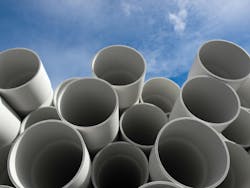Behind the standards & testing of U.S. water infrastructure materials
PVC pipes, particularly those used in our water systems and referenced in the Bipartisan Infrastructure Law, have been a hot topic over the past year. As an industry, we know the project materials used for our water lines, including water mains, service lines, and hot and cold distribution piping within buildings are required to be certified to NSF/ANSI/CAN 61: Drinking Water System Components – Health Effects verify that the materials do not cause any negative health effects. Most recently, lead service lines are receiving media attention as they now require replacement. However, much of the public is not familiar with the rigorous certification process for these products and it has become increasingly important to educate communities about these product evaluations to promote assurance and build trust in our continuously improving water systems.
How standards are developed
The development of standards like NSF/ANSI/CAN 61 is coordinated by NSF which operates through a public process to ensure equal input of all stakeholders. The process includes a joint committee with balanced representation from public health and regulatory officials, industry representatives and product manufacturers.
In the second phase of developing standards, the review process requires a two-thirds majority rule vote to pass the relevant joint committee that covers the proposed standard’s scope. The proposed standard needs a 90% vote to pass the PHC (Public Health Council). At this stage, negative feedback is accepted and must be addressed and settled before passing the PHC. If successful, concluding this process, the standard will then be published.
Once a standard is developed and published, it is continuously evaluated to ensure it is current with the latest technology and science available. Along with this, the levels of contaminants allowed under NSF/ANSI/CAN 61, are listed in NSF/ANSI/CAN 600: Health Effects Evaluation and Criteria for Chemicals in Drinking Water. These drinking water criteria are developed and regularly updated according to risk assessment procedures in NSF/ANSI/CAN 600. Following a public process, the procedures are peer-reviewed by the Joint Committee, NSF HAB (Health Advisory Board) and the PHC.
Testing PVC pipes to NSF/ANSI/CAN 61
Manufacturers interested in certifying their products to NSF/ANSI/CAN 61, should understand the process in order to properly prepare. In addition, manufacturers seeking testing services must provide product formulation information including its suppliers' names and formulary ingredient tradenames. The authorized registered formula (ARF) is required for manufacturers to use the NSF mark upon earning certification and any adjustments to it must be reported. A change may mean the product must undergo additional testing to ensure the products continue to meet the rigorous requirements of NSF/ANSI/CAN 61.
Following the product formulation review, NSF conducts an on-site audit for the production facility and collects product samples to be submitted for testing with NSF’s labs. Auditors verify all aspects of the production process, including purchasing, production, shipping, training and quality control records. If the products pass the requirements to NSF/ANSI/CAN 61, a final technical evaluation will be completed before the product receives NSF certification.
It is important to note that testing is not a one-and-done process. For PVC specifically, manufacturing facilities receive a minimum of two inspections per year to ensure they continue to meet NSF/ANSI/CAN 61 specifications. NSF-certified products are tested annually, but residual vinyl chloride monomer (RVCM) products are tested at least twice per year. The pass/fail levels for NSF/ANSI/CAN 61 are established in NSF/ANSI/CAN 600 and are dependent on the specific chemical extractant. If the contaminant is regulated by U.S. Environmental Protection Agency (EPA) or Health Canada, the acceptance criteria is based on the regulated level. If the contaminant is not regulated, the toxicology criteria for establishing acceptance criteria is also in the standard.
NSF/ANSI/CAN 61
Since its development in 1989, NSF/ANSI/CAN 61 has greatly contributed to protecting human health. The standard covers materials and products that come into contact with drinking water and/or drinking water treatment chemicals. Protective barrier materials, mechanical devices, joining and sealing materials, pipes and related equipment, plumbing devices, process media and nonmetallic potable water materials are all covered under the scope of this standard. It serves as the America National Standard and the National Standard of Canada and is required in 48 U.S. states and 11 Canadian provinces.
NSF testing & certification
Operating since 1944, NSF is a not-for-profit organization, meaning it receives no government funding for its standards or certification services. Its mission is to improve global human and planet health and carries out this mission as an independent, ISO-accredited standards development organization. As a separate sector from standards development, NSF’s labs and certification programs are also accredited by the American National Standards Institute (ANSI) and the Standards Council of Canada (SCC) to ISO/IEC 17025 and ISO/IEC 17065, which verify its impartiality and ability to generate valid results.
NSF has been testing products to NSF/ANSI/CAN 61 since 1989, spanning over 2,000 companies and over 62,000 products. Product certification is conducted through a fee-for-service model. Payment for testing has no bearing on if manufacturers will receive product certification; in fact, approximately 17% of products submitted for certification fail to meet standard NSF/ANSI/CAN 61 requirements upon initial testing. The fee is used to cover the costs of the scientists, engineers, labs, auditors and toxicologists needed to operate. Additionally, manufacturers do not have input on the safety assessment of their products. Products that fail certification testing are kept out of the marketplace.
Leading With Science
Understandably, the public is becoming more aware and involved in the safety of the water systems they use and how they may affect their health. It is important to provide easily accessible and factual information to reassure our communities that the industry utilizes the most current science and is taking the necessary steps to ensure products used in public water systems are certified for safety and will not cause adverse health effects. Consumers can check NSF’s Certified Products and Systems Listing page to see which products are certified.
